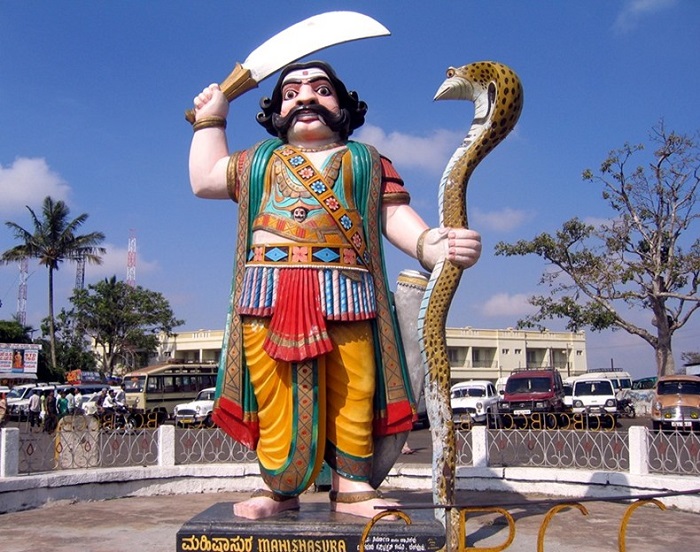Know your festival – Mysore Dussehra
In continuation of our ‘know your festival’ series, see how processions of elephants, horses and dancers bring out the vibrancy and colour of the Dusshera festival celebrated in Mysore.
Celebrations in Mysore
Mysore Dussehra season stands out in the South for the colourful ambience that this princely city presents every year. Processions featuring Elephants, horses, and folk dancers through the streets of the city, coupled with the hugely popular Dussehra Exhibition, attract a large number of families with kids from all over. The sheer number of visitors who take part in this colourful event, provide glamour and festivity to this historic town.
The story behind
Mysore has a special connection with Dussehra because of a folklore associated with it. The name of the city is derived from ‘Mahishana Ooru’ which means ‘the city of Mahisha’ in Kannada. Mahisha is none other than the symbolic evil Mahishasura, who ruled over it ruthlessly. It is believed that Goddess Durga descended on earth to destroy the demon on the Dussehra day to free its people of his cruelty. There is a gigantic statue of the ferocious demon on top of the Chamundi hills, the spot where he was finally slain. It is believed that, having accomplished her mission on Earth, the goddess stayed back on the same hill as Chamundeshwari to assure the city of peace and prosperity.

Festivities seen today follow a tradition originating from the days of the Vijayanagar Empire. The Maharajas of Mysore always started celebrations with a ritual pooja in the temple on top of the Chamundi Hill as well as at the gates of the palace. A procession called Jamboo Savari proceeded to ‘Bannimantapa’ with the king seated on the gold hoodah on the colourfully decorated elephant with foot soldiers and soldiers on horses with folk dancers as accompaniment. Upon reaching Bannimantapa, the king symbolically cut a branch of the Banni tree to perform his duty as a Kshatriya.
Each evening, the Maharaja gave audience to distinguished visitors, artists, officials and others in a ‘Durbar’. Musical concerts, wrestling matches and other entertainment were features of the Durbar. Old timers remember the magnificent ambience at the Mysore Palace of those days!
Although the days of Maharajas are over, processions and ceremonies are still held in their original form as an annual tourist attraction today. As in those days, the palace and the temple over the Chamundi Hill are fully lit up to provide a rare visual treat!
The ceremonies
Public happenings like processions, fairs and exhibitions are typical of Mysore. In each home in Southern India, however, festivities involve an interesting and unique feature called Bombe Habba in Karnataka, Bommala Koluvu in Andhra or Bommai Kolu in Tamilnadu.
Preparations for Dussehra start with building of a stepped platform having an odd number of tiers, covered neatly with new cloth. Each family owns a collection of dolls of various forms specially for Dussehra and tradition involves arranging these toys and dolls in stepped tiers in clusters, presented as a ‘doll exhibition’.
A unique feature all over south India during the festival of Navaratri is an interesting tradition called Bombe Habba in Karnataka, Bommala Koluvu in Andhra or Bommai Kolu in Tamilnadu. Each family owns a collection of dolls of various forms and tradition involved arranging these toys and dolls in stepped tiers in clusters, presented as a ‘doll exhibition’.
The festivities
Preparations for Dussehra start with building of a stepped platform having an odd number of tiers, covered neatly with new cloth. Each family owns a collection of dolls of various forms specially for Dussehra and tradition involves arranging these toys and dolls in stepped tiers in clusters, presented as a ‘doll exhibition’.
Two dolls depicting a husband and a wife dressed colorfully (called Pattada Gombe or Pattath bommaikal) are set at a central spot. (Traditionally this pair of dolls is passed on from mothers to their daughters at their wedding).
The Pattada Gombe pair is always the centerpiece, while idols or dolls depicting gods and goddesses make up the rest of the arrangement. It is common to see idol sets of Rama /Lakshmana/ Seeta/Hanuman, Radha /Krishna, Shiva/ Parvati, Vishnu /Lakshmi, Durga, Saraswati, arranged neatly in the top tiers. Other fancy dolls depict ordinary people and their place is in the lower tiers.
On the lowest terrace, it was a tradition for children of the family to create an exhibit featuring a typical scene from everyday life, such as a park. A bed of dampened soil on a tray was the starter. Grains of Ragi (as seed) sowed well in time would grow into a dense green patch. By trimming this green turf, a typical park and street scene, complete with lamp posts, shops and figures of people would be created imaginatively. There was always a lot of excitement in this work for all the kids!
Concurrently, for the rest of the family, there are many events like the Saraswati Pooja, when all books along with pens and other devices used in the learning process are worshipped. Ayudha Pooja, is when every tool and implement used in day to day life including cars and vehicles are washed clean, put together, decorated and worshipped with Chandan, vermillion and Aartis.
Navaratri is indeed a big family event when every home is decorated with plenty of flowers and rangolis of all designs and sizes accompanied by festive spread of eating.